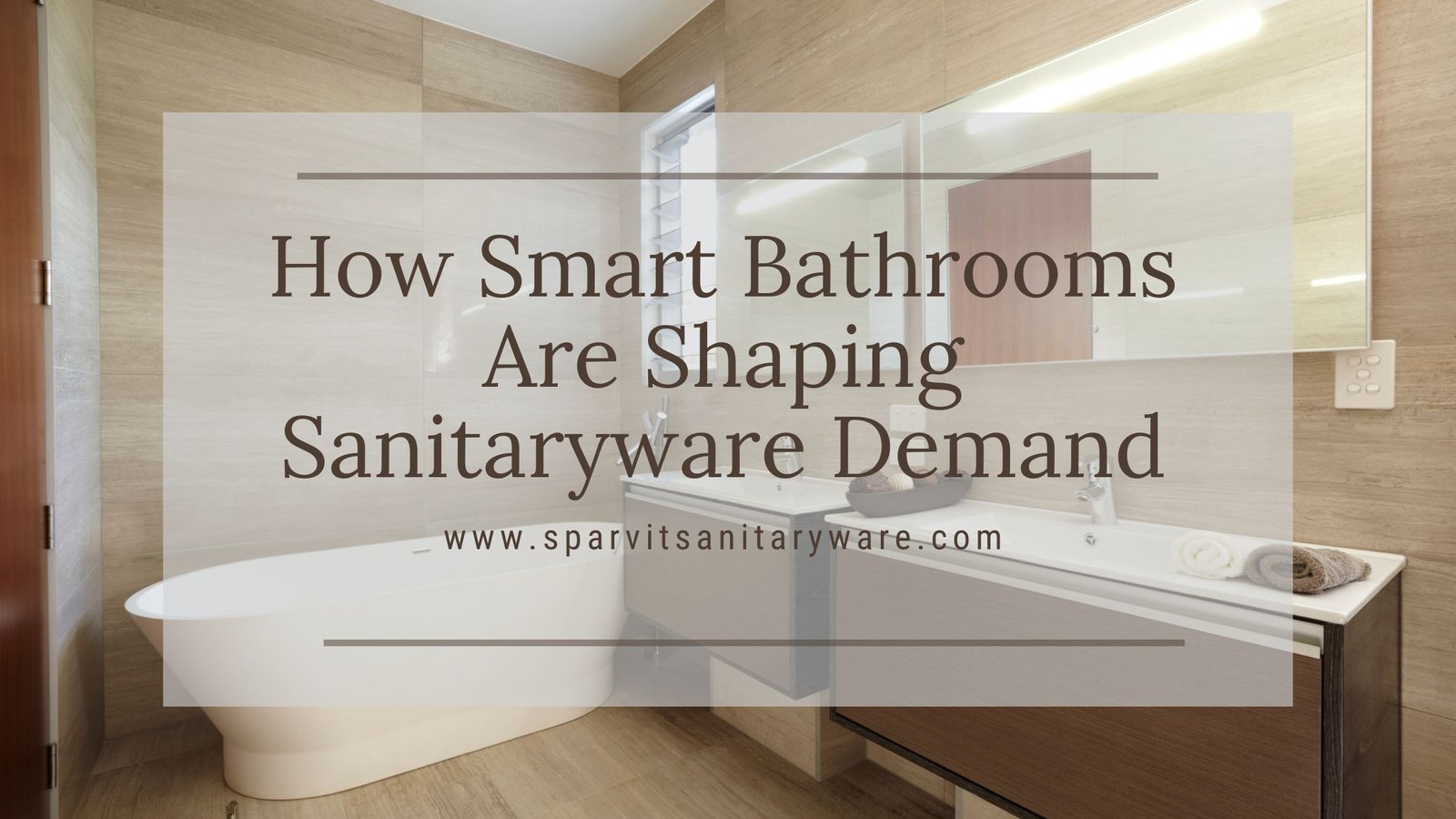Introduction
The concept of modern bathrooms has undergone a massive transformation. Gone are the days when bathrooms were solely functional spaces; today, they are smart, technology-driven environments that emphasize hygiene, convenience, aesthetics, and sustainability. This evolution has had a profound impact on the sanitaryware industry, driving new demand patterns, changing consumer expectations, and prompting manufacturers to innovate at unprecedented rates.
Smart bathrooms incorporate features such as sensor-based faucets, touchless toilets, smart showers, automated lighting, and health monitoring systems, all designed to enhance the user experience. These innovations not only improve hygiene but also contribute to water and energy efficiency—an increasingly important factor in both residential and commercial projects.
As a leading Sanitaryware Manufacturer, Sparvit Sanitary has observed firsthand how these technological advancements are reshaping the industry. In this blog, we explore ten key ways smart bathrooms are influencing sanitaryware demand, backed by market trends, examples, and insights.
1. Rise of Touchless & Sensor-Enabled Sanitaryware
One of the most significant trends in smart bathrooms is the widespread adoption of touchless technology.
Key Features:
- Sensor-activated faucets and urinals prevent direct contact, reducing the risk of disease transmission.
- Automatic flush systems in toilets improve hygiene while conserving water.
- Touchless soap dispensers and hand dryers enhance convenience and reduce contamination.
Market Impact:
The growing awareness of hygiene post-pandemic has increased the demand for sensor-based sanitaryware by over 35% in urban areas.
Case Study:
A corporate office in Mumbai replaced all traditional faucets with sensor-enabled faucets. This led to a 25% reduction in water consumption, improved employee satisfaction, and influenced other office complexes to adopt similar upgrades.
Implication for Manufacturers:
Sanitaryware manufacturers now need to integrate electronic components, sensors, and water-saving technologies into their products. This has led to a surge in demand for high-quality, durable sensor-based faucets, urinals, and flush systems.
2. Growing Popularity of Smart Toilets
Smart toilets have become a central feature in modern bathrooms, combining comfort, hygiene, and technology.
Key Features:
- Bidet functionality with adjustable water pressure and temperature.
- Heated seats, self-cleaning mechanisms, and night lights.
- Odor control and automated lid operation for convenience.
Market Impact:
Smart toilets are driving demand for premium sanitaryware. Manufacturers are investing in tech-integrated ceramic and composite products to meet this growing need.
Case Study:
A 5-star hotel chain in Delhi installed smart toilets in all rooms. Customer satisfaction scores increased by 20%, and the property gained a reputation for luxury and hygiene, highlighting the value of smart sanitaryware in the hospitality sector.
3. Integration with Home Automation Systems
Smart bathrooms are no longer isolated; they integrate seamlessly with IoT and home automation systems.
Features:
- Control over lighting, water temperature, and flush mechanisms via smartphone apps.
- Voice-activated shower and faucet control for hands-free convenience.
- Data collection for maintenance alerts, water usage tracking, and energy monitoring.
Impact on Manufacturers:
Sanitaryware manufacturers must now produce IoT-compatible products, investing in software integration and hardware reliability. This opens opportunities for higher-margin smart fixtures that appeal to tech-savvy consumers.
Example:
Luxury apartments in Bangalore now offer fully automated bathrooms, allowing residents to control all fixtures remotely, making such developments highly attractive in a competitive real estate market.
4. Water Efficiency & Sustainability Driving Product Choices
Sustainability has become a critical driver for sanitaryware demand. Smart bathrooms focus on efficient water usage and eco-friendly operations.
Features:
- Dual-flush toilets and low-flow faucets.
- Sensor-activated showers and taps that prevent unnecessary water wastage.
- Water recycling and filtration systems integrated into bathroom design.
Market Implication:
Developers and homeowners increasingly prioritize eco-friendly sanitaryware, pushing manufacturers to innovate.
Case Study:
A residential complex in Pune installed Sparvit Sanitary’s water-efficient smart fixtures. Water usage decreased by 30%, demonstrating the economic and environmental benefits of smart bathroom technology.
5. Demand for Premium Materials and Finishes
Smart bathrooms combine technology with aesthetics.
Features:
- High-gloss ceramics, anti-bacterial coatings, tempered glass panels, and metallic finishes.
- Durable materials that complement touchless and sensor-based functionality.
Market Effect:
The demand for premium finishes is growing in luxury residential and commercial projects, leading manufacturers to invest in advanced processing and material technology.
Example:
Hotels and high-end apartments increasingly request customized finishes that pair aesthetic appeal with smart functionality, ensuring high consumer satisfaction and brand loyalty.
6. Health & Wellness Features Influencing Demand
Health and wellness integration is a key trend in smart bathrooms.
Features:
- UV sterilization of toilet seats and faucets.
- Water quality monitoring for showers and taps.
- Ergonomically designed fixtures for the elderly and differently-abled users.
Market Impact:
Manufacturers are now producing health-focused smart sanitaryware, meeting the requirements of hospitals, wellness centers, and residential customers seeking enhanced hygiene and comfort.
Example:
Healthcare facilities in metro cities are increasingly installing smart toilets and faucets to maintain high standards of hygiene, creating a specialized market segment for sanitaryware manufacturers.
7. Commercial Sector Driving Bulk Orders
Smart bathrooms are not limited to homes; commercial projects are driving large-scale demand.
Key Areas:
- Hotels, malls, airports, and corporate offices installing smart fixtures.
- Bulk procurement for standardization and ease of maintenance.
- Integration with facility management systems for alerts and maintenance.
Market Opportunity:
Sanitaryware manufacturers are now catering to high-volume commercial orders, increasing production scales and revenue.
Example:
An international airport installed over 1,000 sensor-based faucets and automated toilets, showcasing the scale and impact of commercial smart bathroom demand.
8. Smart Bathrooms and Real Estate Value
Smart bathrooms enhance property value and appeal.
Key Features:
- Luxury amenities with high-tech fixtures increase marketability.
- Developers use smart bathrooms as differentiators in competitive real estate markets.
- Customizable solutions allow unique offerings for high-end clients.
Example:
Real estate projects in Mumbai and Gurugram have marketed smart bathrooms as a premium feature, influencing purchase decisions and pricing.
Impact on Manufacturers:
Sanitaryware manufacturers must provide tailored solutions for residential and commercial developers, ensuring compatibility with design and technology requirements.
9. Challenges for Manufacturers
While demand is rising, manufacturers face challenges:
- High production costs due to electronics integration.
- Skilled labor required for assembly and maintenance.
- Rapid technological updates necessitating continuous R&D.
- Market competition from domestic and international brands.
Sparvit Sanitary Approach: The company invests in R&D, staff training, and quality assurance to maintain leadership in the smart sanitaryware market.
10. Future Trends Shaping Sanitaryware Demand
- AI-enabled bathrooms predicting maintenance needs.
- Voice-activated systems for hands-free control.
- Expansion of smart bathroom adoption in tier-2 and tier-3 cities.
- Integration with energy and water monitoring systems for sustainable usage.
Implications for Manufacturers: Continuous innovation, product diversification, and consumer education are essential to remain competitive.
Conclusion
Smart bathrooms are reshaping the sanitaryware industry, driving demand for:
- Sensor-based and touchless fixtures
- Water-efficient and eco-friendly products
- Premium, aesthetically appealing sanitaryware
- Health and wellness-focused features
- Integrated technology solutions for residential and commercial projects
Sparvit Sanitary, as a leading Sanitaryware Manufacturer, delivers innovative, high-quality smart bathroom solutions that meet these growing demands. Manufacturers and developers who invest in smart sanitaryware today are positioning themselves for long-term growth, customer satisfaction, and sustainability in a competitive market.
The future of bathrooms is smart, sustainable, and tech-enabled, and sanitaryware manufacturers like Sparvit Sanitary are leading the way.






